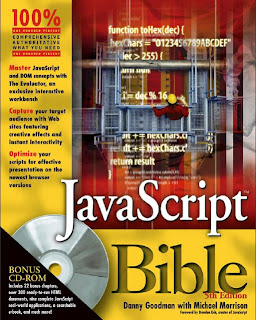Writer
Danny Goodman
Michael Morrison
Published Year: 2004 (5th Edition)
Publisher: Wiley Publishing, Inc.
ISBN: 0-7645-5743-2
Page: 1743 Pages
Size: 6.83 MB (zip)
Content that you use to learn the fundamentals of JavaScript and reference frequently are at your fingertips in the printed version, while chapters with advanced content are in the searchable electronic version on the CD-ROM. Here are some details about the book’s structure.
Part I
Part I of the book begins with a chapter that shows how JavaScript compares with Java and discusses its role within the rest of the World Wide Web. The Web browser and scripting world have undergone significant changes since JavaScript first arrived on the scene. That’s why Chapter 2 is devoted to addressing challenges facing scripters who must develop applications for both single- and cross-platform browser audiences amid rapidly changing standards efforts. Chapter 3 provides the first foray into JavaScript, where you get to write your first practical script.
Part II
All of Part II is handed over to a tutorial for newcomers to JavaScript. Nine lessons provide you with a gradual path through browser internals, basic programming skills, and genuine browser scripting with an emphasis on industry standards as supported by most of the scriptable browsers in use today. Exercises follow at the end of each lesson to help reinforce what you just learned and challenge you to use your new knowledge (you’ll find answers to the exercises in Appendix C). The goal of the tutorial is to equip you with sufficient experience to start scripting simple pages right away while making it easier for you to understand the in-depth discussions and examples in the rest of the book. By the end of the final lesson, you’ll know how to create the mouse-rollover image swapping effect that is popular in a lot of Web pages these days, and modify the content of a Web page dynamically.
Part III
Part III, the largest section of the book, provides in-depth coverage of the document object models as implemented in today’s browsers. In all reference chapters, a compatibility chart indicates the browser version that supports each object and object feature. One chapter in particular, Chapter 15, contains reference material that is shared by most of the remaining chapters of Part III. To help you refer back to Chapter 15 from other chapters, a dark tab along the outside edge of the page shows you at a glance where the chapter is located. Additional navigation aids include guide words near the tops of most pages to indicate which object and object feature is covered on the page.
Part IV
Reference information for the core JavaScript language fills Part IV. As with reference chapters of Part III, the JavaScript chapters display browser compatibility charts for every JavaScript language term. Guide words near the tops of pages help you find a particular term quickly.


No comments:
Post a Comment